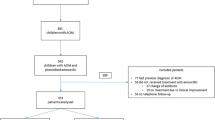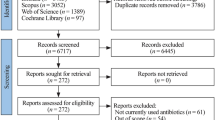Abstract
An open multicentre study was conducted in 484 children between the ages of 6 months and 12 years with otitis media to compare the efficacy, the safety and the tolerance of once-daily azithromycin given for three days versus thrice-daily amoxicillin/clavulanic acid (CA) given for ten days. A satisfactory response (cure plus improvement) was noted 10 to 14 days after the start of treatment in 199 of 215 (92.6 %) azithromycin-treated children and in 186 of 198 (93.9 %) amoxicillin/CA-treated children. The relationship between treatment and clinical response was independent of chronicity of infection and the presence or absence of a perforated eardrum. Improvement in signs and symptoms of otitis media occurred significantly more rapidly in the children treated with azithromycin. Treatment-related or possibly treatment-related adverse events were recorded in 11 of 243 (4.5 %) azithromycin-treated patients and in 20 of 240 (8.3 %) treated with amoxicillin/CA. No patients in the azithromycin treatment group were withdrawn from treatment, but six amoxicillin/CA patients, including two < 2 years of age, discontinued treatment prematurely because of adverse events; the difference between treatment groups was statistically significant (p=0.0146). It is concluded that azithromycin given as an oral suspension once daily for three days is as safe and effective as amoxicillin/CA given thrice daily for ten days in the treatment of children with otitis media.
Similar content being viewed by others
References
Fiese EF, Steffen SH: Comparison of the acid stability of azithromycin and erythromycin A. Journal of Antimicrobial Chemotherapy 1990, 25, Supplement A: 39–47.
Foulds G, Shepard RM, Johnson RB: The pharmacokinetics of azithromycin in human tissues and serum. Journal of Antimicrobial Chemotherapy 1990, 25, Supplement A: 73–82.
Retsema JA, Girard AE, Girard D, Milisen WB: Relationship of high tissue concentrations of azithromycin to bactericidal activity and efficacy in vivo. Journal of Antimicrobial Chemotherapy 1990, 25, Supplement A: 83–89.
Shepard RM, Falkner FC: Pharmacokinetics of azithromycin in rats and dogs. Journal of Antimicrobial Chemotherapy 1990, 25, Supplement A: 49–60.
Panteix G, Guillaumond B, Harf R, Desbos A, Sapin V, Leclercq M, Perrin-Fayolle M: In-vitro concentration of azithromycin in human phagocytic cells. Journal of Antimicrobial Chemotherapy 1993, 31, Supplement E: 1–4.
Girard AE, Cimochowski CR, Faiella JA: The comparative activity of azithromycin, macrolides and amoxicillinagainst streptococci in experimental infections. Journal of Antimicrobial Chemotherapy 1993, 31, Supplement E: 29–37.
Girard D, Bergeron JM, Milisen WB, Retsema JA: Comparison of azithromycin, roxithromycin and cephalexin penetration kinetics in early and mature abscesses. Journal of Antimicrobial Chemotherapy 1993, 31, Supplement E: 17–28.
Retsema JA, Girard A, Schekly W, Manousos M, Anderson M, Bright G, Borovoy R, Brennan L, Mason R: Spectrum and mode of action of azithromycin (CP-62,993), a new 15-membered-ring macrolide with improved potency against gram-negative organisms. Antimicrobial Agents and Chemotherapy 1987, 31: 1939–1947.
Dunkin KT, Jones S, Howard AJ: The in-vitro activity of CP-62,993 againstHaemophilus influenzae, Branhamella catarrhalis, staphylococci and streptococci. Journal of Antimicrobial Chemotherapy 1988, 21: 405–411.
Hardy DJ, Hensey DM, Beyer JM, Vojtko C, McDonald EJ, Fernandes P: Comparative in vitro activities of new 14-, 15-, and 16-membered macrolides. Antimicrobial Agents and Chemotherapy 1988, 32: 1710–1719.
Goldstein FW, Emirian MF, Coutrot A, Acar JF: Bacteriostatic and bactericidal activity of azithromycin againstHaemophilus influenzae. Journal of Antimicrobial Chemotherapy 1990, 25, Supplement A: 25–28.
Arnoff SC, Laurent C, Jacobs MR: In-vitro activity of erythromycin, roxithromycin and CP-62,993 against common paediatric pathogens. Journal of Antimicrobial Chemotherapy 1987, 19: 275–276.
Maskell JP, Sefton AM, Williams JD: Comparative in-vitro activity of azithromycin and erythromycin against grampositive cocci,Haemophilus influenzae and anaerobes. Journal of Antimicrobial Chemotherapy 1990, 25, Supplement A: 19–24.
Felstead SJ, Daniel R, and the European Paediatric Study Group: Short-course treatment of sinusitis and other upper respiratory tract infections with azithromycin: a comparison with erythromycin and amoxycillin. Journal of International Medical Research 1991, 19: 363–372.
Müller O: Comparison of azithromycin versus clarithromycin in the treatment of patients with upper respiratory tract infections. Journal of Antimicrobial Chemotherapy 1993, 31, Supplement E: 137–146.
Daniel RR: Comparison of azithromycin and co-amoxiclav in the treatment of otitis media in children. Journal of Antimicrobial Chemotherapy 1993, 31, Supplement E: 65–71.
Mohs E, Rodriguez-Solares A, Rivas E, El Hoshy Z:A comparative study of azithromycin and amoxicillin in paediatric patients with acute otitis media. Journal of Antimicrobial Chemotherapy 1993, 31, Supplement E: 73–79.
Pestalozza G, Coice C, Facchi M: Azithromycin in upper respiratory tract infections: a clinical trial in children with otitis media. Scandinavian Journal of Infectious Diseases 1993, 83: 22–25.
Schaad UB: Multicentre evaluation of azithromycin in comparison with co-amoxiclav for the treatment of acute otitis media in children. Journal of Antimicrobial Chemotherapy 1993; 31, Supplement E: 81–88.
National Committee for Clinical Laboratory Standards: Development of in vitro susceptibility testing criteria and quality control parameters. Tentative guideline M23-T. NCCLS, Villanova, PA, 1992.
Bluestone CD: Augmentin therapy for acute otitis media in children: summary of presentations from four clinical trials. In: Bluestone CD (ed); Postgraduate medicine: progress and perspectives on beta-lactamase inhibition: a review of augmentin. McGraw Hill, New York, 1984, p. 137–139.
Hopkins S: Clinical safety and toleration of azithromycin in children. Journal of Antimicrobial Chemotherapy 1993, 31, Supplement E: 111–117.
Bergman AB, Werner RJ: Failure of children to receive penicillin by mouth. New England Journal of Medicine 1963, 268: 1334–1338.
Cockburn J, Gibberd RW, Reid AL, Sanson-Fisher RW: Determinants of non-compliance with short-term antibiotic regimens. British Medical Journal 1987, 295: 814–818.
Greenberg RN: Overview of patient compliance with medication dosing. Clinical Therapeutics 1984, 6: 592–599.
Author information
Authors and Affiliations
Rights and permissions
About this article
Cite this article
Principi, N. Multicentre comparative study of the efficacy and safety of azithromycin compared with amoxicillin/clavulanic acid in the treatment of paediatric patients with otitis media. Eur. J. Clin. Microbiol. Infect. Dis. 14, 669–676 (1995). https://doi.org/10.1007/BF01690872
Issue Date:
DOI: https://doi.org/10.1007/BF01690872




